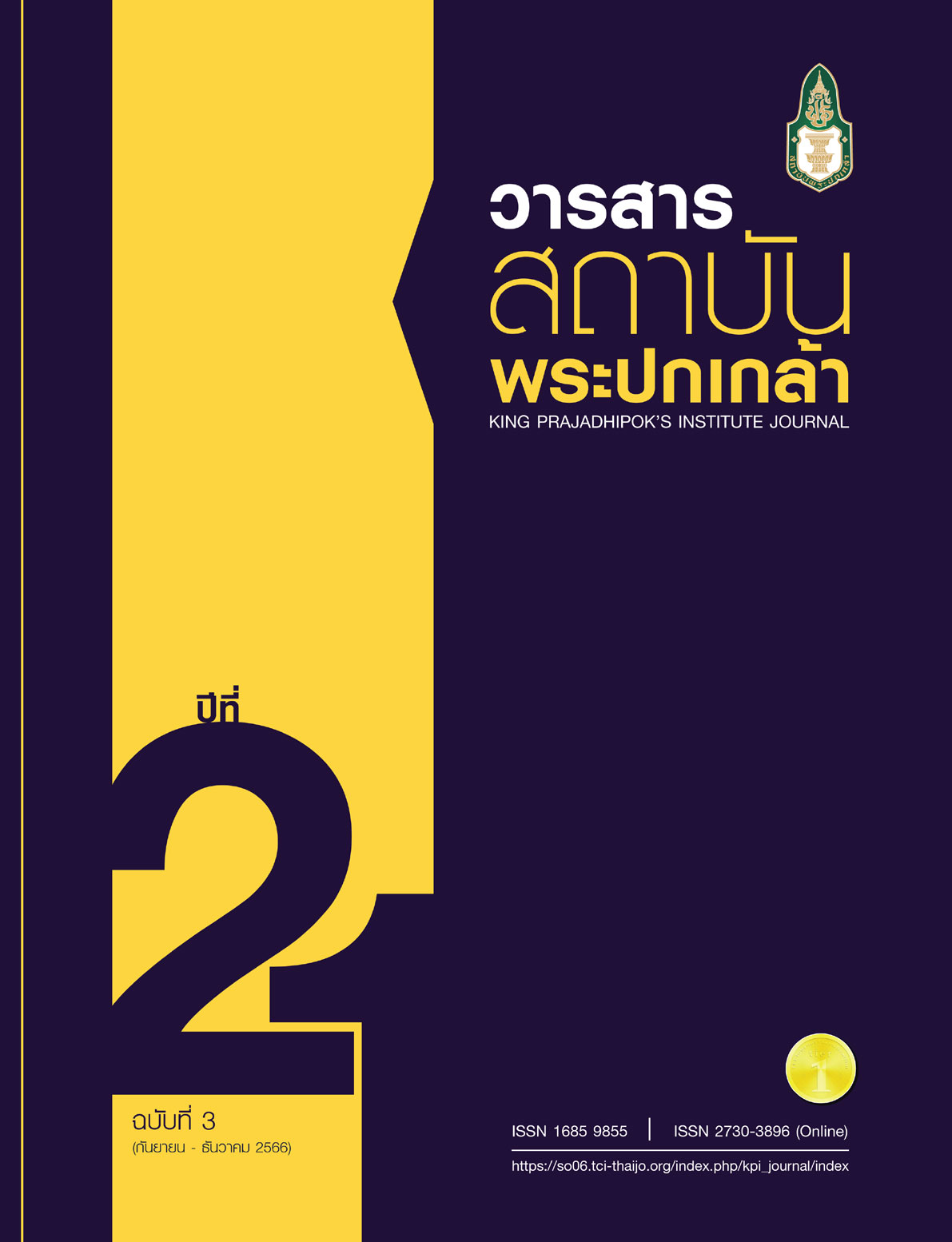การขับเคลื่อนความเป็นพลเมืองเข้มแข็งผ่านมุมมองการจัดการปกครองสาธารณะแนวใหม่
Main Article Content
บทคัดย่อ
บทความนี้มีวัตถุประสงค์เพื่อนำเสนอบทวิเคราะห์เชิงวิพากษ์ของการก่อเกิดความเป็นพลเมืองเข้มแข็ง พร้อมทั้งนำเสนอเส้นทางการขับเคลื่อนพลเมืองเข้มแข็งในบริบทของประเทศไทย โดยเป็นการศึกษาภายใต้ขอบเขตแนวคิดการจัดการปกครองสาธารณะแนวใหม่ (New Public Governance: NPG)
ที่ครอบคลุมถึงความสัมพันธ์ของการจัดการภาครัฐ (Intergovernmental Management: IGM) โดยใช้ฐานคิดของการจัดการปกครองแบบประสานความร่วมมือ (Collaborative Governance: CG) ในการวิเคราะห์ถึงสาเหตุและเงื่อนไขของการเป็นพลเมืองเข้มแข็งจากตัวอย่างในอุทยานแห่งชาติโกลเดนเกต (Golden Gate) ซึ่งสะท้อนให้เห็นถึงกลไกของการขับเคลื่อนพลังเครือข่ายในมิติต่างๆ ที่มีจุดเริ่มต้นมาจากผู้นำที่พร้อมเผชิญหน้ากับปัญหา โดยสามารถเปลี่ยนจากวิกฤตเป็นโอกาสในการพัฒนาพื้นที่ร่วมกันได้ อย่างไรก็ตาม
การนำเสนอจุดร่วมของพลังเครือข่ายสามารถอธิบายภายใต้แบบจำลอง “พลังพลเมืองเข้มแข็งลูกใหม่” เพื่อให้เห็นภาพของการขับเคลื่อนโดยเปลี่ยนจากตัวแสดงหลักที่เป็นภาครัฐมาเป็นภาคประชาชน แต่ถึงกระนั้นสิ่งสำคัญ คือ การค้นหาจุดร่วมในการพัฒนาภายใต้บทบาทหน้าที่ที่ตนเองสามารถกระทำได้ ซึ่งถือเป็นพื้นฐานของการเปลี่ยนผ่านทางความคิดเพื่อมุ่งไปสู่ความเป็นพลเมืองเข้มแข็งที่มีบทบาทสำคัญต่อการพัฒนาประเทศไทยในกระแสสังคมโลก
Article Details

อนุญาตภายใต้เงื่อนไข Creative Commons Attribution-NonCommercial-NoDerivatives 4.0 International License.
@ 2020 King Prajadhipok's Institute The Government Complex Commemorating All Right Reserved.
เอกสารอ้างอิง
ภาษาไทย
จีระ หงส์ลดารมภ์. (2555). 8K’s + 5K’s ทุนมนุษย์ของคนไทยรองรับประชาคมอาเซียน. กรุงเทพฯ: บริษัท มิสเตอร์ก็อปปี้ (ประเทศไทย) จำกัด.
ประเวศ วะสี. (2551). ยุทธศาสตร์ อบต.: จุดเปลี่ยนประเทศไทย. กรุงเทพฯ: สำนักงานกองทุนสนับสนุนการสร้างเสริมสุขภาพ.
พระพรหมคุณาภรณ์ (ป. อ. ปยุตฺโต). (2546). ภาวะผู้นำ พระธรรมปิฎก (ป. อ. ปยุตฺโต). กรุงเทพฯ: บริษัท วอง ออโตโมบิล จำกัด บริษัท วอง ฮอนด้าคาร์ส์ จำกัด และบริษัท วอง จิวเวลรี่ จำกัด.
ภาษาต่างประเทศ
Agranoff, R.J. (1986). Intergovernmental Management: Human Service Problem Solving in Six Metropolitan Areas. Albany: State University of New York Press.
Ansell, C. & Gash, A. (2008). Collaborative Governance in Theory and Practice. Journal of Public Administration Research and Theory, 18(4), 543-571.
Bovaird, T. & Loffler, U. (2005). Strategic Management in Public Sector Organization. In Public Management and Governance. London: Taylor and Francis Group.
Bowornwathana, B. (2010). Minnowbrook IV in 2028: From American Minnowbrook to Global Minnowbrook. Public Administration Review, 70(1), 64-68.
Cheema, G.S. (2005). From Public Administration to Governance: The Paradigm Shift in the Link between Government and Citizens. In The 6th Global Forum on Reinventing Government towards Participatory and Transparent Governance (pp. 646-654). Seoul: Republic of Korea.
Giddens, A. (1984). The Constitution of Society. California: University of California Press.
Gilby, S. et al. (2019). Sustainable Lifestyles Policy and Practice: Challenges and Way Forward. Kanagawa: Institute for Global Environmental Strategies.
Goldsmith, S. & Eggers, W.D. (2004). Governing by Network: The New Shape of the Public Sector. Washington: Brookings Institution Press.
Hobbes, T. (1999). Leviathan. Eugene: University of Oregon.
Kennett, P.A. (2010). Global Perspective on Governance. In Stephen P. Osborne (Ed.), The New Public Governance?: Emerging Perspectives on the Theory and Practice of Public Governance (pp. 19-35). London: Routledge.
Kettnerm, J.H. (1978). The Development of American Citizenship. Chapel Hill, N.C.: University of North Carolina Press.
Loffler, E. (2005). Governance and Government: Networking with External Stakeholders. In Tony Bovaird & Elke Loffler (Eds.), Public Management and Governance (pp. 3-22). London: Taylor & Francis Group.
Marshall, T.H. (2009). Citizenship and Social class. In Jeff Manza & Michael Sauder (Eds.), Inequality and Society (pp. 148-154). New York: W.W. Norton and Company.
McGettigan, T. (2011). Good Science: The Pursuit of Truth and Evolution of Reality. MD: Lexington Books.
National Association of Corporate Directors (NACD). (2021). 2022 Governance Outlook. Suite: National Association of Corporate Directors.
Organization for Economic Co-operation and Development (OECD). (2011). Doing Better for Families: Families are changing. Paris: OECD Publishing.
Organization for Economic Co-operation and Development (OECD). (2022). OECD Secretary-General’s Report to G20 Finance Ministers and Central Bank Governors on the Review of the G20/OECD Principles of Corporate Governance. Paris: OECD Publishing.
Osborne, S.P. (2010). The New Public Governance?. Oxon: Routledge.
Parson, W. (1995). Public Policy: An Introduction to the Theory and Practice of Policy Analysis. Cambridge: Cambridge University Press.
Pestoff, V. (2010). New Public Governance, Co-production & Third Sector Social Service. Sweden: Ersta Skondal University Collage, Stockholm.
Radin, B.A. (2003). The Instruments of Intergovernmental Management. In B. Guy Peters & Jon Pierre (Eds), Handbook of Public Administration (pp. 366-374). London: SAGE Publication Ltd.
Reilly, T. (1998). Communities in Conflict: Resolving Differences Through Collaborative Efforts in Environmental Planning and Human Service Delivery. Journal of Sociology and Welfare, 25, 115-142.
Rhodes, R. (1997). Understanding Governance: Policy Network, Governance, Reflexivity and Accountability. Buckingham: Open University Press.
Sorenzen, E. & Torfing, J. (2008). Theoretical Approaches to Democratic Network Governance. London: Palgrave Macmillan.
Stivers, C. (1990). Active Citizenship and Public Administration. In Gay L. Wamsley et al., Refounding Public Administration. California: Sage Publication Ltd.
Stoker, G. (1998). Governance as theory: Five propositions. International Social Science Journal, 50(155), 17-28.
Terziev, V. & Vasileva, S. (2022). The Role of Education in Socialization of an Individual. In INTCESS 2022- 9th International Conference on Education & Education of Social Sciences (pp. 518-523). Online Conference.
United Nations (UN). (2013). Economic and Social Commission for Asia and the Pacific: What is Good Governance?. Vienna: UN Building.
Wamsley, G.L. (1990). Refounding Public Administration. California: Sage Publication.
Wilson, W. (2007). The Study of Administration. In Jay M. Shafritz & Albert C. Hyde, Classics of Public Administration. Wadsworth: Cengage Learning.


